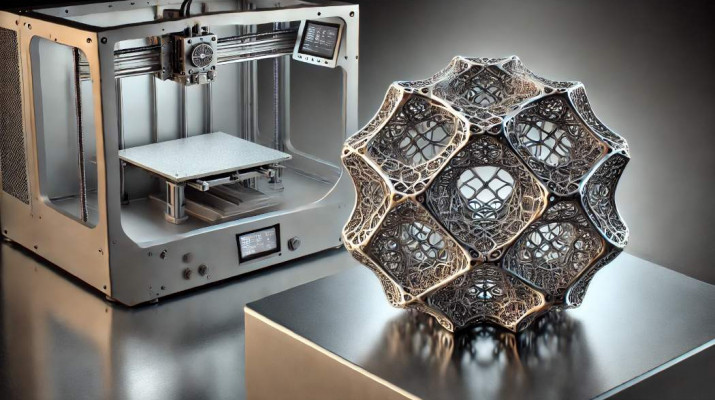3D printing with metals, also known as metal additive manufacturing, is one of the latest technologies revolutionizing the manufacturing industry. It enables the creation of complex, durable, and lightweight components that were previously difficult or even impossible to produce using traditional metal processing methods.
How Does Metal 3D Printing Work?
Metal 3D printing is based on additive manufacturing technology, as opposed to subtractive methods like machining. The process involves layering metal powder and sintering or melting it using a laser beam, electron beam, or another energy source. The most commonly used methods include:
- Selective Laser Melting (SLM) – Fuses metal powder using a laser.
- Direct Metal Laser Sintering (DMLS) – Sintering metal with a laser without fully melting the powder.
- Electron Beam Melting (EBM) – Utilizes an electron beam instead of a laser, enabling printing in a vacuum.
- Binder Jetting – Combines metal powder with a binder, followed by sintering in a furnace.
Applications of Metal 3D Printing
Metal 3D printing technology is widely used across various industrial sectors:
- Aerospace: Manufacturing lightweight and durable jet engine parts, structural components of spacecraft, and satellite components.
- Medicine: Producing personalized orthopedic implants, prosthetics, and surgical tools.
- Automotive: Printing engine parts, turbochargers, gearboxes, and other precision components.
- Energy Industry: Producing parts for gas and wind turbines with optimized shapes and improved efficiency.
- Tooling Industry: Creating specialized molds and tools with complex geometries.
Advantages of Metal 3D Printing
Metal 3D printing offers numerous benefits that make it highly attractive:
- Reduced Material Waste: The process uses only the material needed, significantly reducing waste.
- Design Freedom: Enables the creation of complex shapes unattainable through traditional methods.
- Shorter Production Time: Printing prototypes and parts on demand eliminates lengthy production waits.
- Customization: Allows the production of unique parts tailored to individual needs.
Metals Used in 3D Printing
A critical aspect of metal 3D printing is the choice of material. The diverse properties of metals enable this technology to serve various industries. Below are some commonly used metals and their characteristics:
Stainless Steel
- Applications: Widely used in medical tools, implants, food industry equipment, and automotive parts due to its corrosion resistance and mechanical strength.
- Properties: High temperature resistance, durability under mechanical stress, and long lifespan.
Titanium
- Applications: Valued for its exceptional strength, lightness, and corrosion resistance, titanium is widely used in aerospace (structural components, engine parts), medicine (orthopedic implants, prosthetics), and automotive industries.
- Properties: Biocompatibility, low density, high resistance to extreme conditions.
Aluminum
- Applications: Used in lightweight and durable components with good thermal and electrical conductivity, especially in aerospace, automotive, and electronics industries.
- Properties: Lightweight, corrosion-resistant, easy to process.
Cobalt-Chromium Alloys
- Applications: Commonly used in medical (dental crowns and bridges, implants) and aerospace industries.
- Properties: Wear resistance, high-temperature and corrosion resistance, excellent mechanical properties.
Nickel and Nickel Alloys
- Applications: Alloys like Inconel are used in extreme temperature environments, such as gas turbines, jet engines, and the chemical industry.
- Properties: High oxidation and corrosion resistance at high temperatures, excellent mechanical properties.
Copper
- Applications: Mainly used in electronics and energy industries for high thermal and electrical conductivity components such as heat exchangers and wires.
- Properties: High thermal and electrical conductivity, malleability.
Gold and Silver
- Applications: Precious metals like gold and silver are used in jewelry and electronics. 3D printing enables the creation of intricate designs such as jewelry and microelectronic components.
- Properties: Excellent electrical conductivity, corrosion resistance, aesthetic appeal.
Magnesium Alloys
- Applications: Increasingly used in aerospace and automotive industries for their exceptional lightness and strength.
- Properties: Low density, good mechanical strength, ease of processing.
Tungsten
- Applications: Tungsten is used in applications requiring high temperature resistance, such as aerospace and energy industries.
- Properties: Extreme temperature resistance, high density, and hardness.
Selecting the Right Metal for 3D Printing
The choice of metal depends on the specific application requirements, such as mechanical strength, corrosion resistance, or thermal conductivity. Metal 3D printing technology accommodates a wide range of metals, making it a versatile tool for industry. As technology advances, the availability of new materials and cost reductions will make metal 3D printing even more accessible.
Challenges and the Future of the Technology
While metal 3D printing has enormous potential, it still faces several challenges:
- High Costs: Metal 3D printers and metal powders are expensive, limiting accessibility.
- Quality Control: Ensuring material uniformity and mechanical properties of printed parts requires advanced technology.
- Scalability: The efficiency of the technology for mass production is still limited compared to traditional methods.
Nevertheless, developments such as cheaper machines, new materials, and improved processes promise a bright future for metal 3D printing. Companies like GE Additive, EOS, and Desktop Metal continue to innovate, expanding the technology’s capabilities and reducing costs.
Summary
Metal 3D printing is a technology that opens up entirely new possibilities in industrial production. It enables the creation of more complex, lightweight, and efficient components that were previously unattainable. With technological advancements and cost reductions, metal 3D printing is poised to become a standard in many industrial sectors in the coming years.

